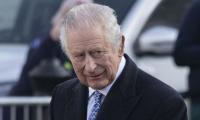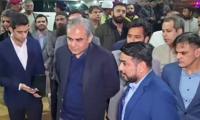It was an honour for me to lead Pakistan’s delegation at the sixth Joint Coordination Committee (JCC) of the China Pakistan Economic Corridor (CPEC) in Beijing, China.
The chief ministers of Sindh, Khyber Pakhtunkhwa (KP), Balochistan and Gilgit-Baltistan (GB) also participated in the meeting on the invitation of the federal government. This high-level representation demonstrated our national commitment for the CPEC above partisan lines. This is great news for Pakistan on two accounts. First, it shows that the CPEC is an inclusive project which Balochistan, KP, Sindh, Punjab, GB and Azad Jammu and Kashmir (AJK) are going to benefit from. Second, all major political parties have come together on the CPEC despite internal political differences. This reflects that the CPEC is a new source of unity and strength in Pakistan.
At the sixth JCC meeting, the scope of the CPEC was vastly expanded by incorporating nine industrial zones, rail-based mass transit projects for each province, Keti Bandar sea port project and energy and infrastructure projects in all provinces and regions. The chief ministers of KP, Sindh, Balochistan and GB expressed full satisfaction and strong support for the CPEC. Prime Minister Nawaz Sharif has made it clear from the outset that the CPEC is a game-changer for Pakistan.
That being said, it is important to refresh our memories. Not too long ago, the Chinese president’s visit to Pakistan was delayed. Some leaders made fun of our claims about the CPEC. But now, it has become obvious to the people of Pakistan which political party stands for economic development and progress in Pakistan.
The CPEC is not only going to revolutionise regional connectivity and trade in the region but it is also going to help Pakistan industrialise itself. Economic history shows that no country has reached high levels of income without industrialisation. To achieve high economic growth, the country has to move from being an agricultural economy to an industrialised economy.
In the 1950s, development economists argued that less-developed countries can climb the economic ladder by using all available means to rapidly undergo industrialisation – that is, a combination of state policies and market forces. In subsequent decades, countries, such as South Korea, Singapore, China and Malaysia achieved rapid economic growth by using effective state intervention to mediate the market forces. Today, these countries are among the industrialised nations of the world.
On the contrary, Pakistan could not utilise its full economic potential – industrialisation and modernisation on a large scale remained a distant dream. As a result, not only was economic growth halted but we could not fully annihilate the quasi-feudal tendencies which are major obstacles in the economic and social development of Pakistan.
But where did we go wrong? Pakistan was set to undergo rapid industrialisation under General Ayub Khan’s regime. Some have dubbed his tenure a ‘decade of development’. Ayub’s regime did achieve rapid rates of economic growth. However, because it was not a democratic regime, massive levels of inequities emerged across class and regional lines, resulting in a political crisis. It eventually led to the tragedy of East Pakistan in 1971. Zulfikar Ali Bhutto’s regime was partly a reaction to socio-economic inequalities produced by Ayub’s regime. Zulfikar Ali Bhutto’s nationalisation of major industries halted the processes of industrialisation in Pakistan. Therefore, at the aggregate level, the overall cost of the Ayub regime’s policies outweighed its benefits.
The economic history of Pakistan is a testimony to the fact that only the governments of Prime Minister Nawaz Sharif consistently and effectively pursued industrialisation policies in Pakistan.
Physical infrastructure lays the foundation for industrialisation. All the major physical infrastructure projects in last three decades were initiated by the PML-N governments. The empirical evidence from Pakistan shows that places which have less-developed physical infrastructure tend to have a low provision of public goods like education and health. Meanwhile, places which have better roads tend to have a better provision of public goods and lower rates of poverty. So I would recommend the naive cynics of the PML-N – who seem to find no utility in physical infrastructure projects – to get some lessons in economic development and economic history.
Unfortunately, PM Sharif’s previous governments in 1990s were not allowed to finish their terms. Political instability was the major hindrance in the path of economic development in Pakistan.
Meanwhile, developed countries of the world have entered into an era of the post-industrial age. They are investing huge sums of money in research and development to control the new drivers of economic growth. As a nation, we must be cognisant of the fact that the dynamics of economic development are rapidly changing. Developing countries can attain high levels of economic growth by being competitive and innovative in global markets.
The CPEC is a recipe to industrialise via its four components: the Gwadar port, road infrastructure, energy and industrial cooperation. The Special Economic Zones (SEZs) are going to be set up in every province of Pakistan. Based on the strengths of the local economies of these regions, industrial plants will be set up.
The following sites have been included in the CPEC in consultation with the provinces during the sixth JCC meeting: Bostan in Balochistan, Rashakai in KP, Dhabeji in Sindh, Sheikhupura in Punjab, Moqpondas in GB, Bhimber in AJK and Mohmand in Fata. The two federal government sites are in Islamabad and Port Qasim. The development of the industrial parks along the CPEC offers unique opportunity for Pakistan to catch up on the industrialisation front.
The CPEC road infrastructure is going to ensure access to markets for producers and consumers. The regional connectivity of the CPEC is going to provide manufacturers in Pakistan access to markets in Central Asia and China. In order to ensure these processes are kicked off, the availability of sufficient energy and security are necessary. That’s why since 2013, Sharif’s government has consistently prioritised the production of energy and the improvement of security situation in Pakistan. Today, even the worst cynics of Sharif’s government cannot deny the fact that Pakistan has enormously improved on both of these accounts.
The reality on the ground is very clear. Pakistan is on the upward trajectory based on all major economic indicators. All major international media outlets, such as The Wall Street Journal, The Economist, Forbes, Bloomberg and The Financial Times have acknowledged this fact. Pakistan has entered 2017 with positivity and hope. But there are some desperate forces in politics and the media in Pakistan whose mission is to propagate despair and negativity. So the real challenge for Pakistan is not its enemies outside but negativists from within who vitiate the gains made by the country for their narrow political agendas. We must keep on marching towards our destination: an industrialised Pakistan.
The writer is the minister for planning and development.
There are over 11 million Pakistanis settled abroad, out of which around six million work in Gulf and Middle East
This year alone, US Treasury would have to roll-over $10 to $14 trillion in maturing short-term debt
Tear gas no longer marks just protest sites; it paints entire cities as battlegrounds but then again, PTI did it first
Political structures and governance systems have been central to economic and social development
It is confirmed now 40 Pakistanis had died after boat of migrants had capsized in sea near Greece
Many people believe that in future, AI will play an even more significant role in their lives







